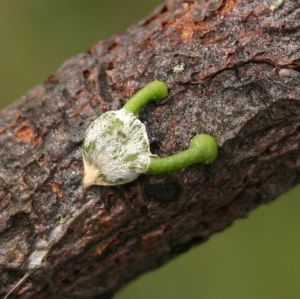Australia has many varieties of mistletoe, valuable for contributing (directly and indirectly) to local biodiversity and also well-known for their Mistletoe Birds which specialise in spreading mistletoe seeds.
But the oddest (and biggest) of them all is the Western Australian Christmas Tree – yes, that’s a tree, and it really is called a Christmas Tree – which is one of the few mistletoe species that’s adapted to parasitize its host’s roots, not its branches. So Nuytsia floribunda, to give it its formal name, looks like an independent plant – a tree or shrub just like any other.

Except that it isn’t – it must be attached to a host. But you can’t tell this by just looking at it.

It became known as a ‘Christmas Tree’ because it flowers, rather abundantly and prettily (hence the floribunda in the name), at Christmas. Which makes sense, though it is a little odd that this ‘Christmas Tree’ is actually a mistletoe.

Nuytsia is still a fairly common sight in the bush – but recent reports suggest it is getting scarcer in urban Perth. A recent study has found that although the attractive trees were often retained when bushland was developed for housing, most have since vanished in housing and park areas. Though they do survive in areas of deliberately-retained bushland – ‘urban bushland’.
The article reporting this doesn’t really speculate on what the mechanism for the loss might be – perhaps the trees aren’t really highly valued and are removed by householders and park managers? Or perhaps there’s something more subtle going on – the ecosystem of housing and parkland areas simply not suiting the species. Perhaps their hosts are compromised in these environments?
There are, perhaps, some parallels with mistletoe in old orchards redeveloped for housing here in the UK – sometimes some of those old mistletoe-bearing orchard trees are retained within new housing developments, but they don’t always fare too well in their new environment of a private back garden or in a ‘public open space’ used as a play area.
In Perth the Wildflower Society have been urging people to value their urban Nuytsia trees, attaching QR codes to them (mistletoe interpretation dragged well and truly into the online age!) and offering Nuytsia seedlings to people who spot them.
Now, you might ask, how can you give out viable seedlings of a parasite that requires host roots to survive? Well, weirdly, Nuytsia seedlings seem quite happy parasitizing grasses – and can survive for a while doing just that. You can even buy Nuytsia seed commercially, though long-term success, beyond a few years living off some grass roots, is said to be limited. This is because mature plants seem to need more substantial hosts – Acacia trees for example. The principle is just the same as an aerial mistletoe – the Nuytsia plants don’t have proper roots as such, and need to link to other, in this case substantial (these are fairly big mistletoes!), host roots to obtain water and nutrients. The host tree(s) can be tens of metres away – Nuytsia ‘roots’ will grow a long way to find a host.
If you do want to grow your own, one final tip – don’t grow it near to underground cables. The questing underground branches of Nuytsia are well-known for damaging, having mistaken them for potential host roots, buried telecoms cables – and have caused significant damage to some Western Australian networks. So string your cables above ground – or use armoured ones.
On SALE pricing (until Christmas Eve)
Mistletoe Grow-kits and Grow-Kit Gift Cards are available from






























